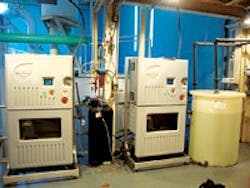Onsite Mixed Oxidants in Cedar Knox
The Cedar Knox Rural Water Project serves approximately 3,500 people, with 820 hookups across four communities in northeast Nebraska. Its drinking water supply comes from the Lewis and Clark Lake, fed by the Missouri and Niobrara Rivers. Average flow is around 300,000 gal per day (gpd), with flows peaking in the summer at 850,000 gpd. Cedar Knox traditionally treated its water with 150-lb chlorine gas cylinders.
Water was leaving the plant at 3 to 3.5 mg/L, and Cedar Knox was still unable to maintain a residual throughout the distribution system. Its desire to improve safety and eliminate all hazardous chemicals led the project team to install onsite mixed-oxidant generators in 2000, with a total capacity of 50 lb per day of free available chlorine (FAC). The disinfectant is injected prior to the clearwell and has about eight hours of detention time before going out to distribution. The distribution system covers 392 miles of pipeline, with the longest reach being 43 miles from the treatment plant.
The pilot project proved that staff could keep the plant at less than 2 mg/L and maintain residual throughout the distribution system—and, with the lower dose, fewer disinfection byproducts (DBPs) would form.
The initial installation entailed two 25-lb-per-day MaximOS systems, which eliminated hazardous chlorine gas and drastically improved the ability to hold a chlorine residual, while reducing trihalomethanes (TTHMs).
The site has since upgraded to two 30-lb-per-day self-cleaning electrolytic cells, which have drastically reduced the amount of maintenance required on the onsite generation units. More importantly, they ensure that the site is operating at the highest salt and energy conversion efficiencies. The electrolytic cells self-clean automatically after 700 hours of operation, which eliminates the need for operators to perform regularly scheduled manual cleanings with mix muriatic acid and water. Acid washing of the new cells has been virtually eliminated and Cedar Knox not seen any problems for quite some time.
How It Works
The mixed-oxidant solution (MOS) is produced by electrolysis of sodium chloride brine in an electrolytic cell that has been optimized for disinfection efficacy. This solution exhibits microbial inactivation properties that are superior to bleach alone. In MOS, FAC is the primary analyzable oxidant constituent. The chemical produced from Parkson MOS generators, however, shows demonstrable differences from bleach in both field and laboratory studies, indicating the presence of other oxidant species beyond FAC alone.
The additional oxidant species in MOS are responsible for enhanced biocidal efficacy (demonstrated on a variety of microorganisms), as well as enhanced behavior in several chemical processes important in water treatment.
Optimal Results
There are several results that have demonstrated the efficacy of MOS over sodium hypochlorite/bleach.
Safety. Operators previously had to transport 150-lb chlorine gas cylinders 45 miles from the office-warehouse building to the treatment plant via pickup truck. The last 8.5 miles were over graveled country roads that could be difficult to travel, especially in inclement weather. Now, employees now have to transport only salt and no longer have to deal with hazardous chemicals at the plant.
Residual maintenance. Cedar Knox has a long distribution system with a maximum reach of 43 miles. The water frequently has a six- to seven-week detention time in winter, with an additional three to four weeks of detention in the distribution system of the neighboring village of Obert. When dosing gas chlorine at 3 mg/L, there frequently was no residual at the longest holding points. Now, mixed oxidants are dosed 30% less at only 2 mg/L and are still able to hold around 0.3 mg/L residual, even after six to seven weeks. The residual lasts throughout Obert’s system as well, with no boosting required.
Pretreatment. Cedar Knox experimented with the use of mixed oxidants in pretreatment and experienced improved filter runs and microflocculation. Due to taste and odor issues, however, it determined that it must add carbon and discontinue pretreatment with mixed oxidants to prevent the oxidant from being consumed by the carbon. The plant has continued to investigate pretreatment options via jar testing and finished water testing. Because of poor raw water quality in 2009, chlorine dioxide was tried as a preoxidant beginning in the fall of 2010. Even with record flooding in 2011 and the resulting poor water quality, the chlorine dioxide and mixed oxidants worked well together.
DBPs. After running the MOS pilot system for a month, total TTHMs were the lowest measured since 1986. A temporary conversion back to chlorine resulted in an immediate increase in TTHMs. Since permanent installation of the system, TTHMs have dropped from more than 100 ppb to less than 80 ppb, and levels at the village of Obert have improved as well. It is anticipated that TTHM levels will be further reduced by introduction of carbon treatment prior to the filters. During the initial mixed oxidant pilot run, the treated water also was tested for bromate and chlorite, both of which were non-detectable.
Download: Here
